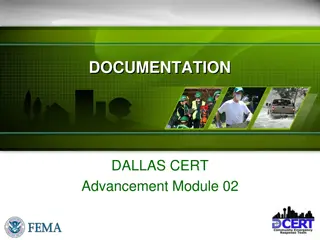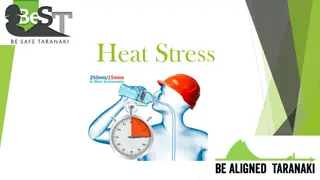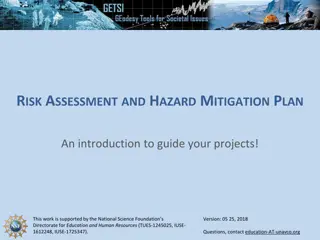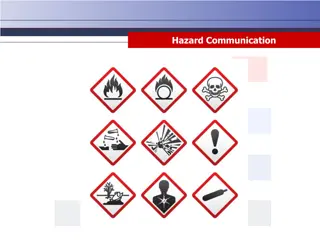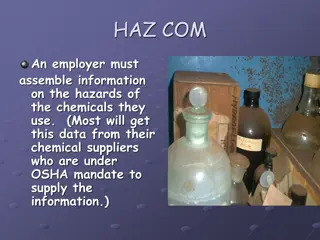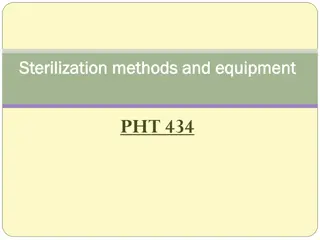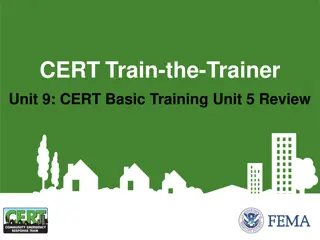Extreme Heat Preparedness and Impacts: CERT Hazard Annexes
Introduction to CERT Hazard Annexes focusing on extreme heat, discussing heat-related illnesses, impacts of extreme heat, and preparedness measures including insulation, window protection, and attic fans. The content emphasizes the preventable nature of heat-related illnesses and the vulnerabilities of certain groups to extreme heat. It also highlights the importance of recognizing and addressing heat-related illnesses promptly to prevent severe outcomes like heat stroke.
Download Presentation

Please find below an Image/Link to download the presentation.
The content on the website is provided AS IS for your information and personal use only. It may not be sold, licensed, or shared on other websites without obtaining consent from the author. Download presentation by click this link. If you encounter any issues during the download, it is possible that the publisher has removed the file from their server.
E N D
Presentation Transcript
CERT Hazard Annex Extreme Heat
Introduction (Annex 3) Extreme heat kills more than 600 people in the United States every year Heat-related deaths and illnesses are preventable Some groups including older adults, young people, outdoor workers, and people with chronic medical conditions are more vulnerable to extreme heat and more likely to develop heat- related illnesses PM EH-1 CERT Hazard Annex: Extreme Heat EH-1
Introduction (Annex 3) (continued) Heat stroke is life-threatening During heat stroke, the body temperature can rise so high that it causes brain damage and can even kill if the body temperature is not lowered to a normal range quickly PM EH-1 CERT Hazard Annex: Extreme Heat EH-2
Extreme Heat Impacts Fatalities People living in urban environments may be at particularly increased risk for death from ambient heat exposure, since urban areas typically have higher heat indexes (combination of heat and humidity) than surrounding suburban or rural areas Disruptions Extreme heat waves can interrupt power and other utility services Generates economic losses from power loss PM EH-1 CERT Hazard Annex: Extreme Heat EH-3
Extreme Heat Impacts (continued) Three main illnesses that can be associated with extreme heat Heat cramps Heat exhaustion Heat stroke Know the symptoms Be ready to give aid Know when to seek medical attention PM EH-1 CERT Hazard Annex: Extreme Heat EH-4
Extreme Heat Preparedness (1 of 3) Install additional insulation Insulation helps keep heat out in the summer as well as to keep heat in during the winter months Protect windows and glass doors Consider keeping storm windows installed throughout the year Use attic fans Because heat rises, attic fans can help clear the hottest air from the home PM EH-1 CERT Hazard Annex: Extreme Heat EH-5
Extreme Heat Preparedness (2 of 3) Install window air conditioners snugly and insulate if necessary Inspect air conditioning ducts for proper insulation Install window reflectors (for use between windows and drapes), such as aluminum foil- covered cardboard, to reflect heat back outside Weather-strip doors and window sills to keep in cool air Cover windows that receive morning or afternoon sun with drapes, shades, awnings, or louvers PM EH-1 CERT Hazard Annex: Extreme Heat EH-6
Extreme Heat Preparedness (3 of 3) Watch and listen to weather reports for three heat- related products from the National Weather Service (NWS) based on the Heat Index The NWS issues the following products when an excessive heat event is likely: 1. Excessive Heat Outlooks: The potential exists in the next 3 to 7 days 2. Excessive Heat Watches: Conditions are favorable in the next 24 to 72 hours 3. Excessive Heat Warnings: An event is expected in the next 36 hours PM EH-2 CERT Hazard Annex: Extreme Heat EH-7
During Extreme Heat (1 of 5) Seek air conditioning If your home does not have air conditioning, you should seek areas that do Schools, libraries, shopping malls, community centers, and many other public places offer good refuges during extreme heat PM EH-2 CERT Hazard Annex: Extreme Heat EH-8
During Extreme Heat (2 of 5) While electric fans may provide comfort, they do not prevent heat-related illness when temperatures reach the high 90s Using a portable electric fan alone when heat index temperatures exceed 99 degrees actually increases the heat stress the body must respond to by blowing air that is warmer than the ideal body temperature over the skin Avoid overexertion and strenuous activities, especially during warmest part of the day Heat-related illness can strike quickly, especially for those performing strenuous work during the heat of the day PM EH-2 CERT Hazard Annex: Extreme Heat EH-9
During Extreme Heat (3 of 5) Wear loose-fitting, lightweight, light-colored clothing Avoid layers and heavier fabrics such as wool Choose polyester or cotton whenever possible as they breathe better Polyester is less absorbent than cotton and therefore allows sweat to evaporate more efficiently than cotton Light colors reflect the sun s rays better than dark colors, which absorb the heat Protect the face and head by wearing a wide-brimmed hat PM EH-2 CERT Hazard Annex: Extreme Heat EH-10
During Extreme Heat (4 of 5) Check on family members and neighbors who: Do not have air conditioning Have medical problems that make them particularly susceptible to heat-related illnesses PM EH-2 CERT Hazard Annex: Extreme Heat EH-11
During Extreme Heat (5 of 5) Drink plenty of fluids Dehydration can occur quickly, go unnoticed, or be mistaken for other illnesses Increasing fluid intake, even if not thirsty, can reduce the risk of dehydration Caution: Persons who are on fluid-restrictive diets (e.g., those with kidney disease) should consult their doctors before increasing fluid intake Take frequent breaks Taking frequent breaks and seeking shade allows the body to cool down PM EH-2 CERT Hazard Annex: Extreme Heat EH-12
Heat Cramps: Symptoms Heat cramps are often the first sign that the body is suffering from extreme heat Symptoms: Muscular pains or spasms, usually in the abdomen, arms, or legs, which may occur with strenuous activity PM EH-3 CERT Hazard Annex: Extreme Heat EH-13
Heat Cramps: Actions Move the person to a cooler location and remove excess clothing Give cool sports drinks containing salt and sugar Do not give liquids with caffeine or alcohol Discontinue liquids if victim becomes nauseous or is nauseated Seek medical attention if: The cramps do not subside in an hour The victim has heart problems The victim is on a low-sodium diet PM EH-3 CERT Hazard Annex: Extreme Heat EH-14
Heat Exhaustion More severe than heat cramps and results from a loss of water and salt in the body May develop quickly after extended exertion or slowly over days of conditions of extreme heat and excessive sweating without adequate fluid and salt replacement PM EH-3 CERT Hazard Annex: Extreme Heat EH-15
Heat Exhaustion: Symptoms Heavy sweating Paleness Muscle cramps Tiredness or weakness Dizziness Headache Nausea or vomiting Fainting PM EH-3 CERT Hazard Annex: Extreme Heat EH-16
Heat Exhaustion: Actions Move the victim to an air conditioned place and lie him or her down Loosen or remove excess clothing Lower the victim s body temperature by placing them in a cool shower or bath, or by applying cool, wet cloths Give sips of water or cool sports drinks containing salt and sugar Do not give liquids with caffeine or alcohol PM EH-3 CERT Hazard Annex: Extreme Heat EH-17
Heat Exhaustion: Actions (continued) Discontinue liquids if the victim becomes nauseous or is nauseated Seek immediate medical attention if there is no improvement, the victim is unable to take fluids, starts vomiting, or exhibits any severe symptoms Seek medical attention if the victim has heart problems or high blood pressure or if the symptoms worsen or last more than one hour PM EH-3 CERT Hazard Annex: Extreme Heat EH-18
Heat Stroke The most serious heat-related illness, heat stroke can cause death or permanent injury and requires immediate medical attention It occurs when the body is no longer able to regulate temperature and is unable to cool down The body s temperature rises rapidly, the sweating mechanism fails, and the body is unable to cool down Body temperature may rise to 106 F or higher within 10 to 15 minutes PM EH-3 CERT Hazard Annex: Extreme Heat EH-19
Heat Stroke: Symptoms An extremely high body temperature (above 103 F) taken orally Red, hot, and dry skin with no sweat Rapid, strong pulse Throbbing headache Dizziness Nausea Confusion Unconsciousness PM EH-3 CERT Hazard Annex: Extreme Heat EH-20
Heat Stroke: Actions (1 of 3) Actions: Call 9-1-1 or emergency medical services, or get the victim to a hospital immediately Delay can be fatal Until the emergency medical personnel arrive on scene or during transport to the hospital, take the following measures: Move the victim to a cooler environment and remove the victim s excess clothing Cool the victim using whatever methods are available PM EH-3 CERT Hazard Annex: Extreme Heat EH-21
Heat Stroke: Actions (2 of 3) Until the emergency medical personnel arrive on scene or during transport to the hospital, take the following measures (continued): Try a cool bath, sponging, ice packs, or wrap the victim s body in a cold, wet sheet to reduce core body temperature Monitor body temperature and continue cooling efforts until the body temperature reaches 101-102 F Do not give the victim fluids to drink Watch for breathing problems PM EH-4 CERT Hazard Annex: Extreme Heat EH-22
Heat Stroke: Actions (3 of 3) Until the emergency medical personnel arrive on scene or during transport to the hospital, take the following measures (continued): Call the hospital emergency room for more instructions if medical response is delayed Sometimes a victim s muscles will begin to twitch uncontrollably as a result of heat stroke. If this happens: Keep the victim from injuring himself but do not place any object in the mouth and do not give fluids Turn the victim on his or her side to make sure the airway remains open in case the victim begins vomiting PM EH-4 CERT Hazard Annex: Extreme Heat EH-23
Final Questions? (Annex 3) Additional questions, comments, or concerns about extreme heat? CERT Hazard Annex: Extreme Heat EH-24











